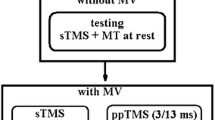Summary
The effect of forearm muscle tendon vibration during alternating step flexion-extension movements about the elbow was studied in normal humans. In one experiment, a vibrator was mounted over either the forearm flexor or the extensor muscle. In a second experiment, a vibrator was mounted over either the forearm muscle or the biceps muscle. In both experiments, vibration was applied either to a single muscle or simultaneously to both muscles during elbow flexion-extension movements. After a period of practice, subjects learned the required movements and were able to make them with their eyes closed. Application of vibration to the forearm and the biceps muscle during extension movements produced an undershoot of the required end movement position. Moreover, application of high frequency vibration (100 Hz) to the forearm extensor and flexor muscle produced an overshoot of the required end-movement position. The observed results are consistent with vibration induced activation of muscle spindle receptors not only in the lengthening muscle during movement but also in the forearm muscles. It is suggested that the pattern of distribution of muscle spindle afferent from the forearm muscle onto α-motoneurons of muscles acting at the elbow has played an important role of alternating step flexion-extension movements.
Similar content being viewed by others
References
Bullen AR, Brunt D (1986) Effect of tendon vibration on unimanual and bimanual movement accuracy. Exp Neurol 93:311–319
Burke D, Hagbarth K-E, Lofstedt L, Wallin BG (1976a) The responses of human muscle spindle endings to vibration of non-contracting muscles. J Physiol (London) 261:673–693
Burke D, Hagbarth K-E, Lofstedt L, Wallin BG (1976b) The responses of human muscle spindle endings to vibration of contracting muscles. J Physiol (London) 261:695–711
Capady C, Cooke JD (1981) The effects of muscle vibration on the attainment of intended final position during voluntary human arm movements. Exp Brain Res 42:228–230
Capady C, Cooke JD (1983) Vibration-induced changes in movement-related EMG activity in humans. Exp Brain Res 52:139–146
Cavallari P, Katz R (1989) Pattern of projections of group I afferents from forearm muscles to motoneurones supplying biceps and triceps muscles in man. Exp Brain Res 78:465–478
Cody FWJ, Schwartz MP, Smit GP (1990) Proprioceptive guidance of human voluntary wrist movements studied using muscle vibration. J Physiol (London) 427:455–470
Gilhodes JC, Roll JP, Tardy-Gervet MF (1986) Perceptual and motor effects of agonist-antagonist muscle vibration in man. Exp Brain Res 61:395–402
Goodwin GM, McCloskey DI, Mathews PBC (1982) The contribution of muscle afferents to kinesthesia shown by vibration induced illusions of movement and by the effects of paralyzing joint afferents. Brain 95:705–748
Inglis JT, Frank JS (1990) The effect of agonist/antagonist muscle vibration on human position sense. Exp Brain Res 81:573–580
Inglis JT, Frank JS, Inglis B (1991) The effect of muscle vibration on human position sense during movements controlled by lengthening muscle contraction. Exp Brain Res 84:631–634
Kasai T (1991) An empirical note on tonic neck reflexes: control of the upper limb's proprioceptive sensation. Percept Mot Skills 72:955–960
Katz R, Morin C, Pierrot-Deseilligny E, Hibino R (1977) Conditioning of H-reflex by a preceding subthreshold tendon reflex stimulus. J Neurol Neurosurg Psychiat 40:575–580
Katz R, Penicaud A, Rossi A (1991) Reciprocal Ia inhibition between elbow flexors and extensors in the human. J Physiol (London) 437:269–286
Roll JP, Vedel JP (1982) Kinesthetic role of muscle afferents in man, studies by tendon vibration and microneurography. Exp Brain Res 47:177–190
Roll JP, Vedel JP, Ribot E (1989) Alteration of proprioceptive messages induced by tendon vibration in man. Exp Brain Res 76:213–222
Sitting AC, Denier vander Gon JJ, Gielen CCAM, van Wijk AJM (1985) The attainment of target position during step-tracking movements despite a shift of initial position. Exp Brain Res 60:407–410
Author information
Authors and Affiliations
Rights and permissions
About this article
Cite this article
Kasai, T., Kawanishi, M. & Yahagi, S. The effects of wrist muscle vibration on human voluntary elbow flexion-extension movements. Exp Brain Res 90, 217–220 (1992). https://doi.org/10.1007/BF00229274
Received:
Accepted:
Issue Date:
DOI: https://doi.org/10.1007/BF00229274




